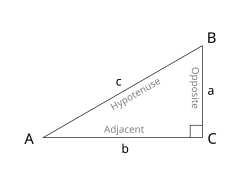TRIGNOMETRY

TRIGNOMETRIC FUNCTION:
1. Sine function(sin), defined as the ratio of the side of the opposite the angle to the hypotenuse.

2. Cosine function(cos), defined as the ratio of the adjacent leg to the hypotenuse.

3. Tangent function(tan), defined as the ratio of the opposite leg to the adjacent leg.

The hypotenuse is the side opposite to the 90 degree angle in a right triangle, it is the longest side of the triangle and one of the two sides adjacent to angle A. The adjacent side is the other side that is adjacent to angle A. The opposite side is the side that is opposite to angle A.
The reciprocals of these functions are named the cosecant(cosec), secant(sec) and cotangent(cot).



USES OF TRIGNOMETRY:
PYTHAGOREAN IDENTITIES:
The identities are related to the Pythagorean theorem and hold for any values.



ANGLE TRANSFORMATION FORMULAE:





TRIGNOMETRIC FUNCTION:
1. Sine function(sin), defined as the ratio of the side of the opposite the angle to the hypotenuse.

2. Cosine function(cos), defined as the ratio of the adjacent leg to the hypotenuse.

3. Tangent function(tan), defined as the ratio of the opposite leg to the adjacent leg.

The hypotenuse is the side opposite to the 90 degree angle in a right triangle, it is the longest side of the triangle and one of the two sides adjacent to angle A. The adjacent side is the other side that is adjacent to angle A. The opposite side is the side that is opposite to angle A.
The reciprocals of these functions are named the cosecant(cosec), secant(sec) and cotangent(cot).



USES OF TRIGNOMETRY:
- The technique of triangulation is used in astronomy to meausre the distance to nearby stars.
- In geography to measure distance between landmarks.
- In satellite navigation system.
- The sine and cosine functions are fundamental to the theory of periodic functions, such as those that describe sound and light waves.
- Fields that use trignometric functions include music theory, audio synthesis, accoustics, optics, electronics, biology, pharmacy, chemistry, number theory, electrical engineering and game development.
PYTHAGOREAN IDENTITIES:
The identities are related to the Pythagorean theorem and hold for any values.



ANGLE TRANSFORMATION FORMULAE:




No comments:
Post a Comment